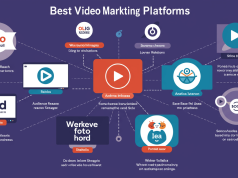Video is no longer just a “nice-to-have” in your marketing toolbox; it’s a must-have. With over 91% of businesses using video as a key part of their marketing strategy and consumers increasingly drawn to engaging and visual content, it’s clear that video holds unparalleled potential for building brand awareness, driving engagement, and ultimately increasing conversions.
But how do you create a video marketing strategy that delivers measurable results? While creating great content is essential, without a solid plan in place, your videos might end up lost in a sea of online noise. Don’t worry—we’ve got you covered! This guide will walk you through each step of building a strategic and effective video marketing plan.
Why Video Marketing Matters

Before jumping into strategy, it’s essential to understand why video marketing is so effective.
- Higher Engagement: Research shows that social media posts with video receive 48% more views than those without.
- Boost in Conversions: Including a video on your landing page can increase conversion rates by up to 80%.
- Improved SEO: Quality video content boosts dwell time on your website, helping your search engine rankings soar.
- Enhanced Consumer Trust: Videos build a human connection with your audience, establishing trust and loyalty.
If you’re not leveraging video marketing, you’re leaving engagement, conversions, and brand growth on the table.
Step 1: Define Your Goals and Target Audience
Every great strategy starts with clear objectives.
Set SMART Goals
Align your video marketing efforts with specific, measurable, achievable, relevant, and time-bound goals. Do you want to:
- Increase brand awareness?
- Drive traffic to your website?
- Boost product sales?
- Educate your audience about your services?
By defining your goals, you’ll have a clear roadmap and can measure success effectively.
Know Your Audience
Understand who you’re targeting. Ask yourself:
- Who are they? (Demographics like age, gender, location)
- What are their pain points and interests?
- Where do they spend time online (e.g., YouTube, Instagram, TikTok)?
Taking the time to define your audience ensures your videos provide value and resonate with the right people.
Step 2: Choose the Right Video Types

Different types of videos achieve different goals. Depending on your objectives, you might opt for the following formats:
Explainer Videos
Perfect for breaking down complex topics. Use these to highlight how your product or service solves a problem.
Product Demos
Show your offerings in action to build excitement and trust.
Testimonials
Authentic customer stories deliver a powerful message and build credibility for your brand.
Behind-the-Scenes
Give a sneak peek into your company culture to humanize your brand and foster deeper connections.
Educational/How-To Videos
Content that teaches your audience something useful naturally builds loyalty and positions you as an industry leader.
Step 3: Plan Your Content and Storyline
Now that you know your audience and video type, it’s time to brainstorm content ideas and plan your story.
Brainstorm Topics
Focus on questions your customers often ask or trending topics in your industry. Use tools like Google Trends or AnswerThePublic to identify content gaps.
Script and Storyboard
Your storyline should:
- Hook viewers immediately (the first 5 seconds are key).
- Address a problem or opportunity.
- Offer a solution (your product, service, or idea).
- Provide a clear call to action (CTA), like “Visit our website,” “Sign up today,” or “Learn more.”
Visualization is critical; include a storyboard to map out scenes. Even the best content suffers without clarity and flow.
Step 4: Production on Any Budget
Contrary to popular belief, video production doesn’t always require expensive tools and studios.
DIY Production
For smaller budgets, smartphones and affordable tripods or ring lights can work wonders. Use simple video editing software like iMovie or Adobe Premiere Rush.
Professional Production
For higher-quality projects or polished branding, consider hiring freelance videographers or creative agencies that specialize in video marketing.
Don’t forget these production essentials:
- Good lighting
- Decent sound quality (external microphones can help)
- Clear visuals (avoid cluttered backdrops)
Step 5: Optimize Your Videos for Distribution
To maximize the effectiveness of your strategy, videos need optimization based on the platforms they’re shared on.
Tailor for Platforms
- YouTube: Use attention-grabbing thumbnails, include SEO-friendly video descriptions, and encourage subscriptions.
- Instagram/TikTok: Craft fast-paced vertical videos (no longer than 60 seconds).
- Facebook/LinkedIn: Include captions; most users watch videos on mute on these platforms.
- Your Website: Place videos prominently on landing pages for high visibility.
Add SEO Details
Use targeted keywords in:
- Titles
- Tags
- Meta descriptions
This improves discoverability in both search engines and platform-specific searches.
Step 6: Promote and Analyze Results
A great video won’t generate traction unless people see it.
Promotion Strategies
- Social Media Campaigns: Schedule posts strategically, incorporate hashtags, and leverage Stories or Reels.
- Email Marketing: Embed videos directly into newsletters. Including the word “video” in subject lines increases email open rates by 19%.
- Paid Ads: Utilize YouTube ads or boosted Facebook posts for extra visibility.
- Collaborations: Partner with influencers to expand your reach.
Measure Performance Metrics
Use analytics tools to track:
- Views and watch time
- Engagement (likes, shares, comments)
- Click-through rates (CTR)
- Conversion rates
Refine your strategy over time based on these insights.
Master Your Video Marketing Strategy Today
An effective video marketing strategy has the power to captivate audiences while driving measurable business growth. By defining clear goals, understanding your audience, and optimizing your videos for each platform, you’ll be well on your way to creating content that stands out, engages viewers, and delivers results.
If you’re ready to take your video marketing to the next level, explore tools like AI-powered video editors or professional creative agencies. The world of video marketing is fast-evolving, and endless opportunities await those ready to innovate.









